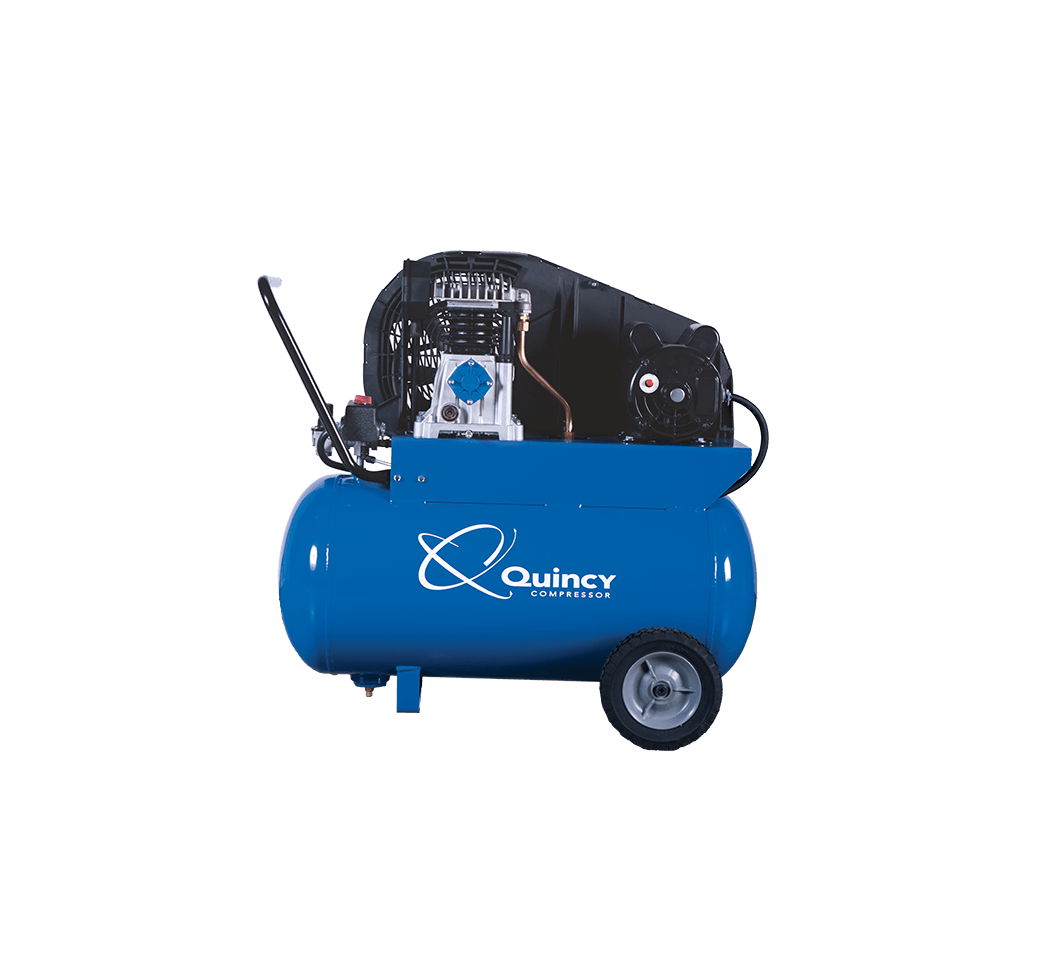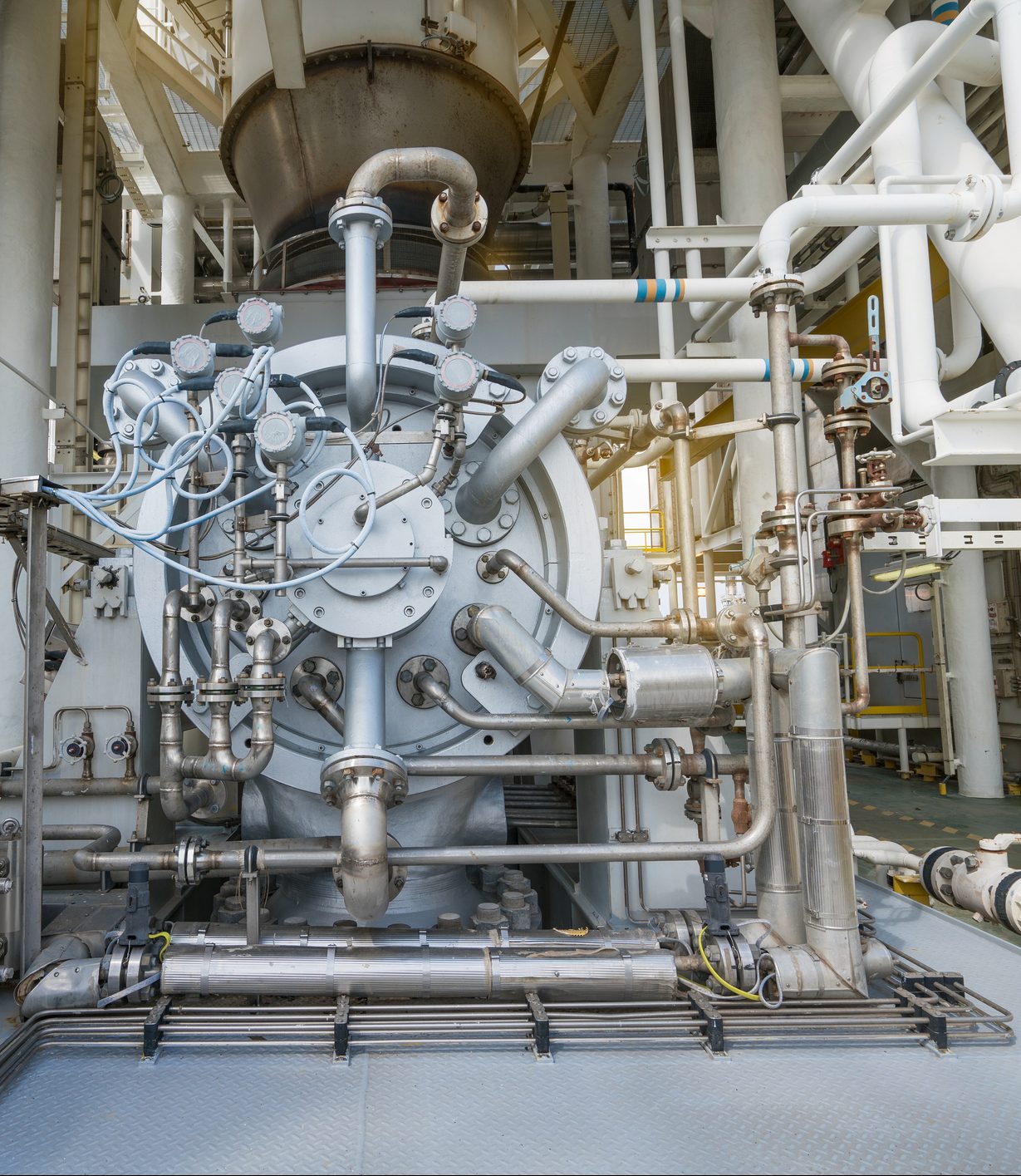
Portable Air Compressors
Quincy Compressor’s portable air compressors offer industry-leading power and efficiency in a small package. They are an excellent choice for home/DIY use, while still delivering the power and reliability necessary for commercial applications. Backed by an industry-leading extended warranty option, Quincy portable air compressors are built for the long haul, providing excellent value in nearly any situation.
If you’re on the market for a new portable air compressor, read on to learn more about why Quincy is the brand of choice for demanding customers.
How Portable Compressors Work
The majority of portable compressors — including those manufactured by Quincy — feature a single-stage, reciprocating/piston design. Piston compressors work by forcing air through an inlet valve into a cylinder, where the reciprocating motion of a piston compresses it. Once it compresses the air to the desired level, it activates a discharge valve, sending it out to power a tool or whatever attachment to which the unit will be connected.
Single-stage compressors feature a single valve and piston assembly. This makes them smaller, lighter and more portable, but limits the amount of power the unit can provide. For this reason, they are most commonly used in garages, workshops, construction sites and other applications where you can sacrifice continuous power for the sake of value or portability.

Finding the Right Product for Your Needs
To select the best portable air compressor for your application, you should consider the following factors:
- Capacity: The capacity of a compressor is the amount of air a unit can produce, measured in CFM (cubic feet/minute). A higher CFM rating means a unit will be able to power more tools at once.
- Pressure: We measure compressor pressure ratings in PSIG (pounds per square inch gauge). Most tools require a continuous pressure of 90 PSIG to operate properly. Other applications require higher or lower pressures. Be clear on your requirements before making a decision.
- Power: The horsepower (HP) of a portable compressor is not directly related to its pressure or capacity; rather, it refers to the efficiency of the unit’s motor. More horsepower is required to drive higher capacity or higher pressure compressors, though a high horsepower unit with low CFM or PSIG ratings will be inefficient and costly to run.
Other things to consider include tank size, whether you want a unit powered by gas or electricity and whether you’ll be working in a sensitive environment where an oil-free design is necessary. For more information about Quincy compressors, visit individual product pages, where you can find detailed specifications and potential applications.
Quincy Portable Compressor Products At a Glance
Quincy’s portable single-stage air compressors boast a number of professional features at a price that’s right for any customer, including:
- A cast-iron cylinder, crankshaft and valve plate, delivering improved durability and strength
- Aluminum head and fin design for improved heat dissipation, reducing wear on the motor
- Working pressures between 110 and 135 PSI, with a standard 1/4″ pressure regulator
- A fully enclosed belt guard and ASME-standard safety valves
Let our team match you with the right portable air compressor for your needs. Contact a sales representative in your area to discuss your intended application today.
At Quincy Compressor, we are also proud to offer high-quality portable air compressor parts.
Learn more about portable single-stage air compressors here.

How to Choose a Portable Air Compressor for DIY Household Maintenance
We’ve all had those projects around the house that were just too difficult to complete without a professional air compressor. Whether you’re painting, working on your car or just inflating some bicycle tires, a portable air compressor is a fantastic investment that will make all sorts of DIY household maintenance projects easier to complete.
What type of air compressor should you look for to help you complete your DIY projects?
Possible Projects Around the House
Household maintenance projects can be completed without a portable air compressor, but why would you put in the extra effort when a little compressed air can make these jobs so much easier?
- Inflating. Whether you’re trying to inflate bicycle tires, car tires or sports equipment, a portable compressor could make the job easier. Plus, it will save your arms — no more handheld pump for you.
- Installing. Hardwood floors, trim and crown molding are great options for adding a bit of class to your home, but without a portable compressor and a nail gun, you’re left placing each nail and hammering it in by hand. For a large area of hardwood flooring or trim, this could take hours.
- Repairing. Do you need a snazzy new fence to surround your property, or do you have one already that is just in need of some repair? A portable compressor, again paired with that nail gun, could make this job a breeze.
- Painting. You’re already dreading breaking out the brushes and rollers, aren’t you? If you’re painting, why not let compressed air do the work for you? Just attach an airbrush to your portable air compressor and go to town — you might never buy another paintbrush, especially since you can use it to paint just about everything from furniture to walls.
Possible Projects in the Garage
If you like working on your cars, a portable air compressor is probably already on your wish list. You can use it for all sorts of things, including:
- Tires. Trying to break loose a lug nut on a tire with just the little bitty lug wrench that comes with your car is a nightmare unless you’re a bodybuilder. Get it done with no effort at all with your air compressor and an impact wrench.
- Maintenance. An air ratchet can be just the thing to break loose those stubborn bolts, or the ones that are just too hard to reach. Instead of busting your knuckles on stuck bolts, bring your compressor along.
- Painting. Just like painting your house, you can use your portable air compressor and an airbrush to paint your car. Get a shop-quality paint job in the comfort of your own garage.
How to Pick a Portable Air Compressor
How can you find the perfect portable air compressor that fits your need? You need to consider four things:
- What you’re doing with the compressor. Are you painting, nailing, working on your car or just inflating some tires? Or are you looking for a multipurpose compressor you can use for all these tasks and more?
- The tool or tools you’re using. Inflating tires requires an inflator. Nailing floorboards requires a nail gun, and working on cars requires a variety of different impact tools.
- The CFM and PSI of the tool. Air compressors have two ratings, other than the tank size — the CFM or cubic feet per minute, and the PSI or pounds per square inch. The CFM determines how fast the air is delivered to your tools — some tools require a higher CFM than others. The PSI determines how hard your tool drives — how much power is behind that impact wrench or air hammer.
- The tank capacity. This variable determines how much air your portable tank can hold before it needs to be refilled. The higher the tank capacity, the longer you can work before you run out of air.
How to Use the Portable Air Compressor
For inflating tires, all you need is a three-gallon tank, unless you’re running a bicycle repair station and are inflating tires all day long. In terms of CFM and PSI, you don’t need a ton of either. Most inflators only require about 0.5 CFM. A 90 PSI tank is more than sufficient for these needs.
For nailing, the tool you’ll need will depend on the job. Flooring nailers are very lightweight pieces of equipment, requiring only 0.2 CFM. Framing nailers, on the other hand, require a little more power — around 3CFM. For running nail guns, you probably shouldn’t need more than a four-gallon tank.
Auto work requires quite a bit of power to run the equipment. An air ratchet, for example, requires an average of 6CFM. The same is required for an impact wrench. Air hammers only require slightly less, coming in at 4CFM.
It’s important to check your particular air tool for its specific CFM requirements. Auto work requires the most air storage, so you’re probably going to need something in the range of an 11-gallon tank or larger. Painting is the most CFM intensive activity. Most paint guns will need between 6-7 CFM and an eight-gallon tank to get the job done.
It is important to note the CFM of your tools — every air tool will have an average CFM rating. The numbers we’ve provided are only estimates. To get the best results out of your portable air compressor, look for one that provides 30-50% more CFM than your tools call for. If you’re going to run more than one tool, combine their required CFM and purchase a compressor that is 30-50% higher than that combined number.


